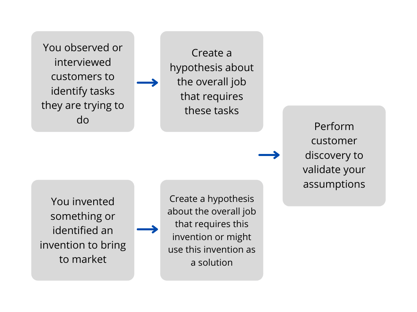Learn how to cater your startup to potential investors using customer discovery and by creating a value proposition.
There are 4 main components of business that make a startup investible:
This article will detail how a unique value proposition and other startup essentials can be used to attract investors to your business.
🔬 Learn about: Funding Options for Biotech Startups
Sometimes startups forget that they need to take a holistic approach when evaluating their venture. For many founders training can be a linear path, but each startup has a unique idea that needs a careful holistic approach. Founders should also understand that as an early stage company, almost everything will be incomplete. In this early stage, the company has a chance to mold how they want the rest of their business to pan out.
One of the most important questions to ask yourself as a startup founder is what problem you are solving. With that, you need to ensure that the problem you are solving is something that the public actually wants solutions to. Will they embrace your startup’s new way of doing things? Or would they prefer to continue to do things as they are?

Investors also look for a competent and adaptable founding team. Having a team that is able to make educated decisions based on investor/customer feedback is essential to maintaining a viable startup. Startups often need to pivot or rearrange their priorities throughout the early stages of the company’s life cycle. Having leadership that is able to organize and adapt efficiently is essential.
Here is a list of questions that an investor may ask themselves when deciding whether to fund a startup:
There are also some differences between types of investors in what they might be looking for. For example, venture capital investors will be looking for a high return on their investment in a relatively short period of time. This is pretty standard for all investors, but the timing and equity percentages that other investors (like Angels or partnerships) look for will differ.
🔬Learn more: How Series A, B, & C Funding Works for Your Startup
Many might think that a startup has the same expectations from investors no matter where they are based. While there are many similarities between geographic regions within investing, there are some differences as well.
For example, in Orange County, startup founders are expected to do extensive market and product research before they come in contact with investors.

In contrast, startups in Silicon Valley are not necessarily expected to complete their market analysis prior to obtaining investors. The mindset in Silicon Valley differs because there is a bigger emphasis on the founder from the investors point of view. The investors in Silicon Valley want to ensure that the founder has the tools and credit that they can achieve something before they fail. In other communities around the world (and even around California) investors are not looking to take that risk.
Despite these geographic differences, there are commonalities amongst all investible startups, regardless of their location.
Your customers have their own jobs that need to get done, and they do not exist to chase your product. They are looking to get gains and avoid pains as they go throughout their job. Their specific job will change depending on the market your startup is in, and each type of customer will have a different job you need to identify. Anthony Ulwick, the founder and Chief Executive Officer of Strategyn, LLC. an innovation consulting firm defines a job as:
“A task, goal, or objective a person is trying to accomplish or a problem they are trying to resolve."
Your value proposition will address the gain you’re promising or the pain that your company can eliminate. When defining your value proposition, you should be thinking in terms of your customer’s point of view, and not the point of view of your company. At the end of the day, the value proposition details the process improvement that your product will bring to the customer.
In order to understand how your product can best serve your customer, you must first understand your customer and their specific needs. When investors inquire why customers will want to purchase your product, you will want to be able to tell them that your solutions come from the analysis of real customer’s problems. This will involve speaking to the people and organizations that you believe will buy your product.
🔬Read More: Implementing Voice of Customer (VOC) in Your Business
You will need to follow a procedure in order to make sure the results of your conversations fit what your customers need. Here is a sample step by step guide:
Create a hypothesis for the type of product your customer would want to use
Talk to various customers in the field you are trying to break into
Validate or invalidate your initial hypothesis
Revise your initial product to reflect customer feedback
Repeat!
This process should allow you to achieve product-market fit. This is when the product you create has a precise match within the market you intend to sell to, ensuring to some extent that the product you develop will sell.
🔬Read More: The Importance of Market Research in Biotech and Medtech Startups
What many people might not know is that there are different categories of value propositions for startups. Sometimes startups can focus too much on a particular category, without taking into account the others. Here are the four categories:
The functional category is for propositions that allow customers to save money, time, or make their lives easier.
Emotional propositions aim to make the customer feel better; this can arise from eliminating the pain in their lives and aiming to make them overall happier.
Life changing propositions are exactly as described, they aim to completely alter a customer’s way of life. A great example of a life changing proposition is the way that MBA programs sell their services. When a university is pitching their MBA program, they make sure to include that completing (and paying for) the program will cause them to get a better job, better career, better friends, better opportunities, etc.
A social impact proposition involves telling the customer of the good that their product will do for the community if the customer purchases it.

The graphic above details the two main ways that startups can create their value propositions. Sometimes, the invention comes first and sometimes the customer discovery comes first. Regardless, the founding team needs to ensure that the product aligns with a particular market, and that the market is ready/needs a product of that type.
In order to complete the last step outlined in the graphic above, you must complete a customer discovery analysis by speaking with multiple (100+) customers in the market. You can first start with your close friends and network, and begin to get contacts from them. You can also connect with potential customers on LinkedIn or at in-person events.
There are two main groups that these questions fall into: current state and future ideal state.
The questions about the current state of the problem/solution can be similar to the following:
These questions aim to help the founding startup team better understand their customers and what they are looking for.
In contrast, the future ideal state questions aim to understand how a new product/solution can make customers' lives easier. For example:
Many early stage companies are afraid of rejection, but these questions are essential to better understanding your product. Gathering this information is important to investors as well, as they want to ensure that your product will be met with demand.
One main rule in these conversations is to not mention your company’s solution to the problem. This allows the customer to formulate their own opinions about the problem and prevents bias in their answer.
The same goes for leading questions, such as, “If there was a product that did __, would you buy it?” These types of questions corner the customer and make them feel as though they need to answer in a particular way.
Below is a guideline that you can use in order to help formulate your company’s value proposition. These points will help you organize your thoughts, while wordsmithing can occur later on in the process.
Your value proposition is an opportunity to show people your company’s mission. It should be shaped by the conversations you have with potential customers, and specific to your market. In the early stages of your proposition you should also remain focused on a very particular type of customer. This helps you refine your product and explain what you aim to do.
Here is an example of a value proposition that follows the above guidelines:
“For working moms who are taking care of their toddlers, we offer self cleaning diapers. It results in incredible time savings, allowing them to spend more time with their children and feel that they are being good parents. We can do it better than the competition because we are the only ones that have the technology to provide that kind of functionality.”
One of the most important things to do as an early stage company is to define your product and ensure that you have a customer base that needs that product. Speaking with customers directly is the best way to make sure that their needs are being met. The next step is creating a value proposition using that data, so that you can easily communicate the aims of your product.
This content comes from a webinar, Creating an Investable Startup: Business Essentials - Part 1 of 4, featuring Laura Beken and Kayvan Baroumand in partnership with the SBDC @ UCI Beall Applied Innovation and University Lab Partners.
📽️ Click here to watch the full webinar.
Be sure to subscribe to the ULP YouTube Channel to never miss another webinar, and connect with us on LinkedIn to stay in the loop!
Download The Ultimate Guide to Wet Lab Incubators in Southern California, a handbook to assist life science start-ups through the entire decision-making process to find wet lab space.
Download Now